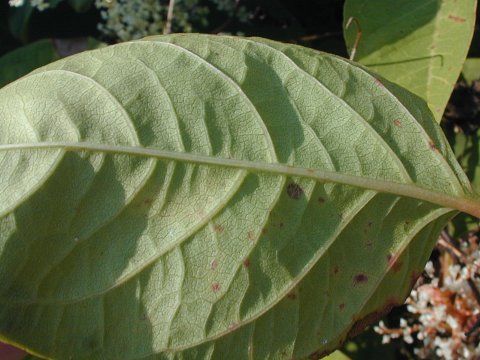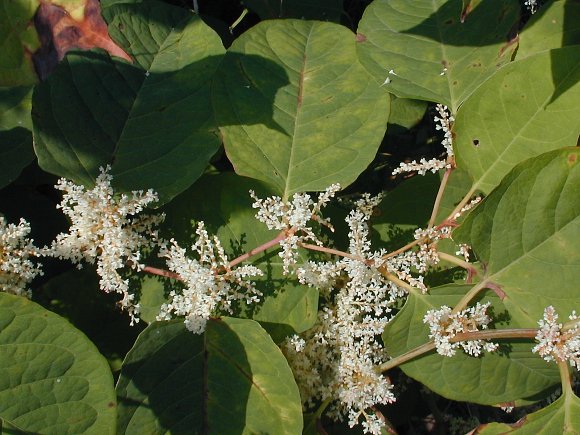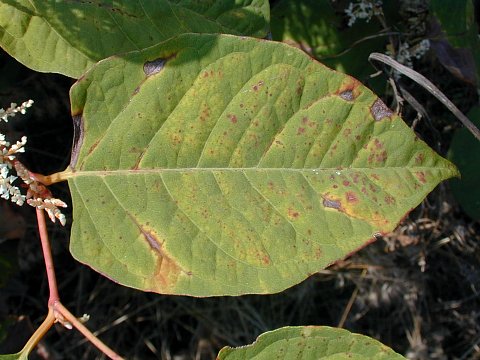Description: This herbaceous perennial plant is 3-8' tall. It branches frequently and has a bushy appearance. While the lower stems appear somewhat woody later in the year, this species dies down to the ground every winter. The hairless stems zigzag back and forth between the alternate leaves, and are somewhat knobby at the base of the petioles. They are often streaked or dotted with reddish tints, and more or less ascending. The hairless leaves are up to 6" long and 4" across. They are broadly ovate, but truncate (rather flat) at the base. Their margins are smooth or slightly undulate, and the pinnate veins on their upper surface are quite conspicuous. The lower surface of the leaves is light green with a reticulated network of fine veins. The petioles are about 1" long and shorter than the leaves.

From the axils of the upper leaves, there develops slender spikes or panicles about 2-4" long that have white or greenish white flowers. The panicles are usually little branched and almost spike-like in appearance. There are usually several of these spikes or panicles per leaf axil, and they have a tendency to spread in all directions. The flowering stalks are slightly pubescent and somewhat knobby where brown papery sheaths occur. From each of these sheaths, there develops several flowers without pedicels. Each flower is about 1/3" (8 mm.) long, consisting of 5 petal-like sepals, 8 white stamens, a tripartite stigma, and no petals. Each outer sepal is broadly winged along its outer surface. Each flower is shaped like a small trumpet, flaring outward from a narrow funnel-like base.

The blooming
period occurs during late summer or early fall, and lasts about 1–1½
months. There is a strong floral scent that is sweet and quite
pleasant. Each flower is replaced by an oblong 3-angled seed that is
shiny and black. The root system is highly rhizomatous and produces
clonal colonies, sometimes of enormous size.
Cultivation:
This species prefers locations with partial to full sunlight, moist to
mesic conditions, and fertile loamy soil. Because of its robust nature,
it will grow in light shade, poor gravelly soil, and drier conditions
as well. During droughts at drier sites, there is a tendency for the
lower leaves to develop brown spots or fall off the stems. The size of
plants is greatly affected by soil fertility and moisture levels. This
is an aggressive spreader.

Range & Habitat: The introduced Japanese Knotweed occurs occasionally in scattered counties throughout Illinois (see Distribution Map). It is somewhat less common in southern and NW Illinois. Habitats include fence rows, areas along roadsides and railroads, sloping banks of large drainage ditches, and miscellaneous waste areas. Sometimes this species is cultivated as an ornamental plant in yards, although the horticultural forms are often smaller in size with more reddish leaves and stems. So far, this species is confined to disturbed areas, but its invasive potential of natural areas is quite high. Where it occurs, Japanese Knotweed often forms large colonies that exclude other plants. It is native to East Asia.

Faunal
Associations:
Primarily bees and wasps are attracted by the flowers, including
bumblebees and honeybees. Various other kinds of insects show up at the
flowers as well, including flies, butterflies, and skippers. Where this
species forms colonies along wetland areas, the seeds may be attractive
to ducks. It is unclear to what extent songbirds and upland gamebirds
use the seeds as a food source. I have seen little evidence that
mammalian herbivores, such as deer and rabbits, feed on the foliage.
Because this species can form dense colonies of plants up to 8' tall,
it is able to provide excellent cover for various kinds of wildlife.
Photographic Location:
Along a railroad in Urbana, Illinois. Not far away, this species also
occurs along the sloping banks of a large drainage ditch.

Comments: This large plant has the potential to become a major pest and it is difficult to eradicate. Japanese Knotweed is much larger and bushier than other members of the Knotweed family that are known to occur in Illinois, with the possible exception of Reynoutria sachalinensis (Giant Knotweed). This latter species is native to Eastern Asia, but it is known to occur in only 3 counties of Illinois. While the base of the leaves of Japanese Knotweed is truncate (flat), the base of the leaves of Giant Knotweed is cordate (indented). An older scientific name for Japanese Knotweed is Polygonum cuspidatum.